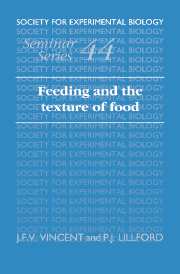Book contents
- Frontmatter
- Contents
- List of contributors
- Introduction
- Mechanical and fracture properties of cellular and fibrous materials
- Texture of plants and fruits
- Measuring meat texture and understanding its structural basis
- Food processing by mastication in cyprinid fish
- Quantitative aspects of the relationship between dentitions and diets
- The control of movements and forces during chewing
- The basic mechanics of mastication: man's adaptive success
- Integrating texture and physiology – techniques
- Brittle textures in processed foods
- The control and generation of texture in soft manufactured foods
- Texture and acceptability of human foods
- Index
Texture and acceptability of human foods
Published online by Cambridge University Press: 14 January 2010
- Frontmatter
- Contents
- List of contributors
- Introduction
- Mechanical and fracture properties of cellular and fibrous materials
- Texture of plants and fruits
- Measuring meat texture and understanding its structural basis
- Food processing by mastication in cyprinid fish
- Quantitative aspects of the relationship between dentitions and diets
- The control of movements and forces during chewing
- The basic mechanics of mastication: man's adaptive success
- Integrating texture and physiology – techniques
- Brittle textures in processed foods
- The control and generation of texture in soft manufactured foods
- Texture and acceptability of human foods
- Index
Summary
Preference (acceptability) and texture perception are judgments made by each of us every time we eat, without much conscious thought. Two groups of experimentalists are interested in how the two are mechanistically linked. They are behavioural psychologists and food product designers. From behavioural studies we can draw a few simple conclusions.
First, eating is not an activity to which a great deal of analytical thought or concentration is normally applied. People behave as if their actions are ‘scripted’, i.e. they are acting out a process during which a sequence of events is to be expected (Abelson, 1981). Only if the unexpected occurs is any judgment logged.
Second, because of the scripted procedures, acceptability of food is dependent on the description or expectation of the properties of the food being eaten. For example, a simple sugar glass can be fabricated into a boiled sweet (hard) or an aerated structure (crunchy). The one is not normally an acceptable form of the other. Fortunately for the confectionery industry, both are acceptable food concepts if properly described. Conversely even if the texture and flavour of two products are closely matched, acceptability will not be obtained unless the concept is acceptable. For example, it has been found that well-matched but unlabelled samples of chicken meat and vegetable protein analogue are equally acceptable, but when the consumer is told which is which, the analogue is rejected because the idea of copying a ‘natural’ product is unacceptable.
Finally, there are some forms of highly nutritious materials which are almost inedible because of their incompatibility with the mechanics of the mouth.
- Type
- Chapter
- Information
- Feeding and the Texture of Food , pp. 231 - 244Publisher: Cambridge University PressPrint publication year: 1991
- 12
- Cited by



